HRM Practices in an Organisation
22 Pages5677 Words293 Views
Added on 2021-02-20
About This Document
3 P2 Strengths and Weaknesses of different approaches of recruitment and selection5 LO 2 7 P3 Benefits of the HRM practices within an organisation for employer and the employee 7 P4 Evaluating the effectiveness of the HRM practices in raising the organisational profit and productivity. 9 LO 3 10 P 5 Impact of the employee relation on the HR decisions 10 P 6 Impact of the employee legislation on the HR decision-making11 LO 4 13 P 7 applications of HRM practices 13 CONCLUSION
HRM Practices in an Organisation
Added on 2021-02-20
ShareRelated Documents
HUMAN RESOURCEMANAGEMENT
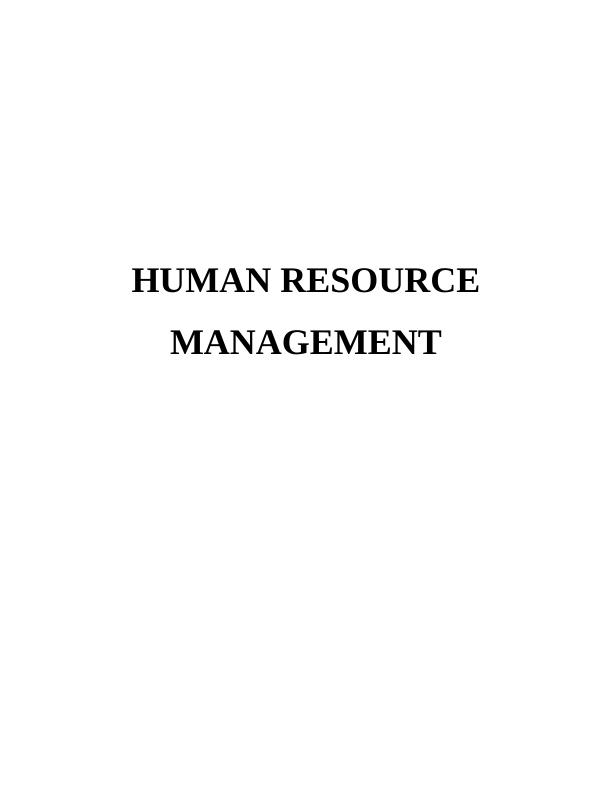
Table of ContentsINTRODUCTION...........................................................................................................................3LO 1.................................................................................................................................................3P1 Purpose and functions of HRM, and their applicability to the workforce planning andresourcing an organisation...........................................................................................................3P2 Strengths and Weaknesses of different approaches of recruitment and selection..................5LO 2.................................................................................................................................................7P3 Benefits of the HRM practices within an organisation for employer and the employee........7P4 Evaluating the effectiveness of the HRM practices in raising the organisational profit andproductivity..................................................................................................................................9LO 3...............................................................................................................................................10P 5 Impact of the employee relation on the HR decisions.........................................................10P 6 Impact of the employee legislation on the HR decision-making........................................11LO 4...............................................................................................................................................13P 7 applications of HRM practices............................................................................................13CONCLUSION..............................................................................................................................14REFERENCE.................................................................................................................................15
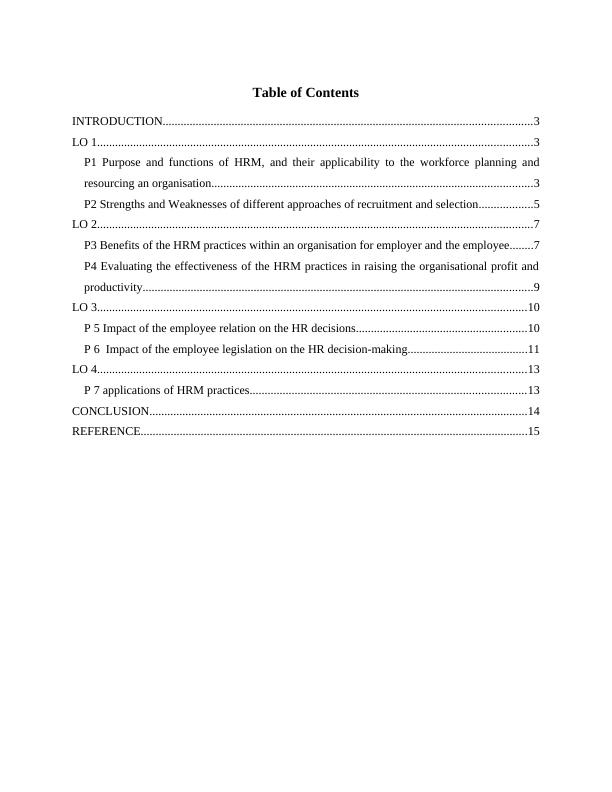
INTRODUCTIONHuman resource management can be considered as the function in an organization whichhelps the organization by mainly focuses on the workforce planning through recruitment andsection, providing the clear guidelines to the manpower by providing the effective training anddevelopment program to them. This functions of the human resource management also concernsabout the employees of the company by hiring, compensation, safety, benefits etc. This report ofthe human resource management is based on the Merrill Lynch company based in London UK.This company works under the financial service industry and provide the investment bankingservices. This report is going to explain the scope, purpose, nature and functions of the humanresource management in context of the workforce planning. Strength and weakness of thedifferent recruitment and selection method will be defined under this report. Furthermore,benefits of the different HRM practice will be analysed for both employees and employers.Evaluation of the different HRM practices will be done that can help to increase the profit andproductivity of the organisation. The report will give an understanding about importance ofemployee relations and their how they affect HR decisions.LO 1P1 Purpose and functions of HRM, and their applicability to the workforce planning andresourcing an organisation.Human resource management is considered to be the internal part of the managementwhich deals with the human resources available in the organisation. The objective behindmaintaining the human resource management is to maintain better relation with the humansworking in their organisation by developing, applying and evaluating the procedures, policiesand programs related to the humans for optimizing their contribution to achieve theorganizational goals and objectives. This will help Merrill Lynch to have an effective andefficient workforce that will help the company to achieve its objectives and goals. Humanresource management takes considerable steps for having the best effective teams and plan forthe tasks which can be nest achieved by them. Purposes of HRMPurpose of Human resource management is concerned with managing number of employee
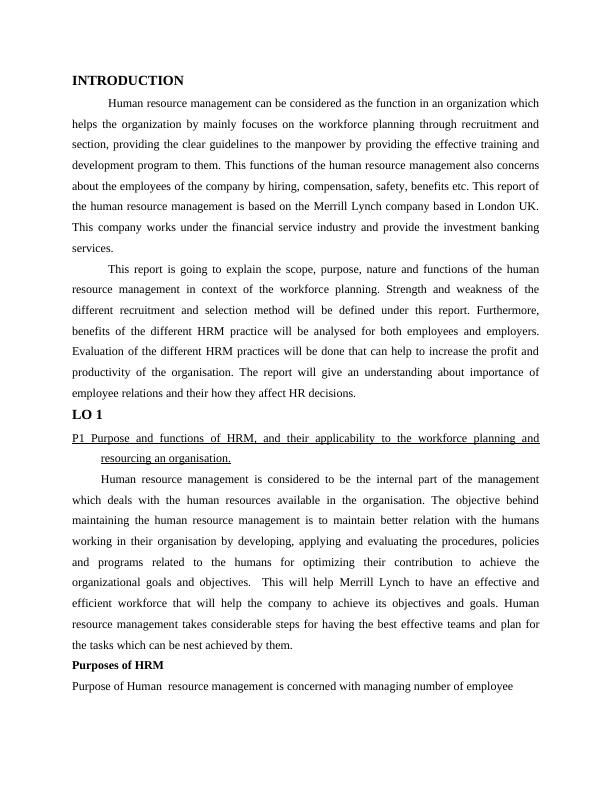
needs. From legal to financial matters, human resource department is concerned with maximising efficiency of organisation.Staffing NeedsHRM has the responsibility of appointing employees. HRM of Merrill Lynch announces positions for duties and jobs. It determines the skills and knowledge that will be required for performinggiven responsibility with efficiency. By identifying staffing needs it will be able to recruit appropriate employees for the roles.Performance appraisalAnother purposes of HRM is to monitor performance of employees, identifying performance isimportant for employees as that will enable HR department to raise their pays and rewards. Performance appraisal help Merrill Lynch to retain employees and also to attract new employees.Functions of HRMGenerally, the management deals with the activities of motivating, hiring and to maintainthe workforce within the organisation. There are two types of functions of Human resourcemanagement. ManagerialOperativeManagerial Function Planning – At planning stage the Merrill Lynch determines how many employees andthe number of professional will be required for accomplishing the organisational objectives. Ithelps the management to gather information about the current and the future needs of thecompany and recruitment staff accordingly (Gerpott, 2015). Organizing – in this management identifies the core areas of the employees and thenallots task according to their skills and knowledge which will help the company to achieve targetobjectives with accuracy as it will be serving in its area.
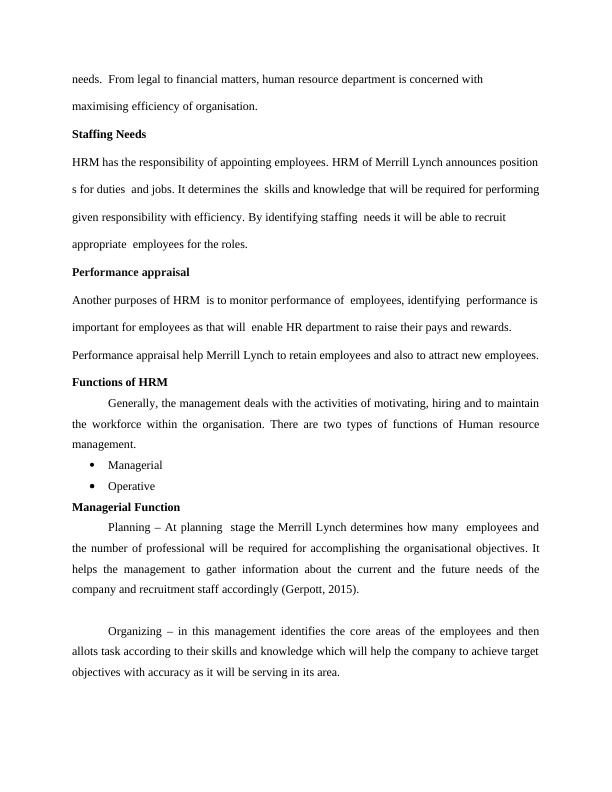
Directing – In this function the employees at every level are motivated to maximise theirefforts towards the achievement of the targeted objectives. Managers boost the maximumpotentialities within an employee to increase their efficiency.Controlling – this is an important function of the management as it deals with havingcontrol over the activities. This helps the organisation to know whether they are performingtowards the defined objectives or not and the management will have to take controlling actions.Operative functionsRecruitment – this is an important function as it deals with hiring candidate for theorganisation who can perform the assigned roles and responsibilities effectively so that thecompany can achieve its goals and objectives Management will have to recruit based on thequalification and the skills they are having to perform the required job.Training and Development- The job of the HR is not restricted to recruiting but also totrain the employees existing in the organisation. HRM of Merrill Lynch conduct programs totrain the employees for enhancing the skill and knowledge.Maintaining effective work environment – another function of HRM is to maintain ahealthy work environment in the company to which help the company to motivate the employeesand increase their efficiency. With this management can operate more effectively and can directthe employees towards the desired objectives of the company. Maintaining a healthyenvironment will produce good relations between the management and the employees and theywill not hesitate to keep their views in favour of the company (Rousseau and Olivas‐Luján,2015). Hard and Soft model for workforce planning and resourcingThere are number of ways of approaching the HR management. Two of the broadapproaches are Hard and Soft.Hard In this approach, employees are treated just like other business resources like machine orbuilding. The HR manager has high focus on the corporate business plans like the resourcerequirement, sources and their costing to the company. In this approach, focus on identifying the
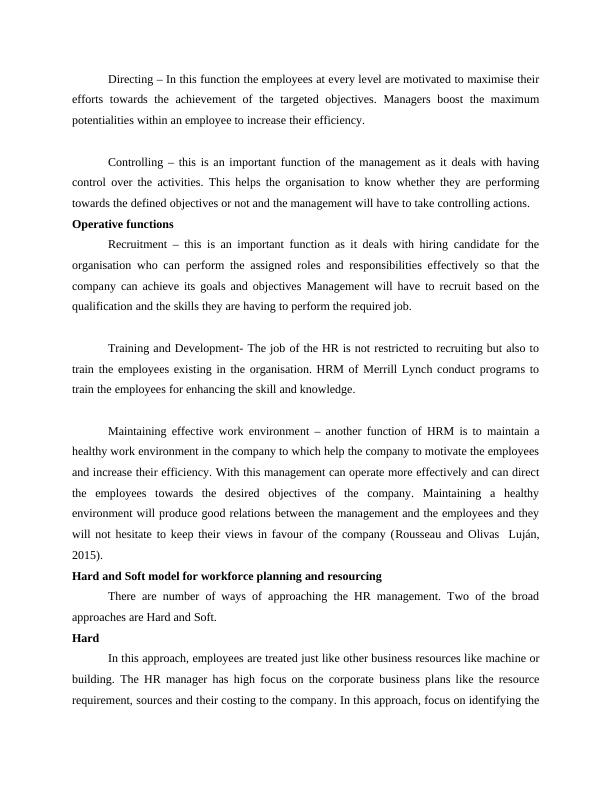
needs of business and recruiting the staff who are strong and can help in achieving theobjectives. This process leads to short term employee retention. There is only communicationfrom top to bottom.SoftIn this approach, employees are treated as important resource of the business that help thecompany to gain competitive advantage in the market. Managers take care of the individualneeds and plan their roles accordingly. This approach is more successful in workforce planningas the employees are involved when allocating the tasks, and they are allocated as per theirspecific fields of interests and expertise. The approach leads to long term planning for theworkforce. In this approach there is strong two-way flow of communication (Girard and Girard,2015). P2 Strengths and Weaknesses of different approaches of recruitment and selectionThere are different approaches to selection Personalised Recruitment Method – The company in this process use face to face way ofrecruiting the employees. The company generally find about their backgrounds and work life.The managers want to be very sure about the person they are recruiting for the organisationwhether an individual is fit for the role and the job. StrengthThis helps them to develop a relationship which will benefit both the company and theorganisation.WeaknessesSome managers are not able to identify the key skill of the candidate Systematic recruitment method – This is the approach where the personal bias is reduced tothe minimum in the selection process. This approach requires a series of procedures which are tobe followed by the organisation for selecting the best candidates. The company following thisapproach gives more satisfied candidate as they are selected on the basis of the tests performedby them. There are 12 procedures followed in the normal recruitment process for selecting thebest out of all the candidates. Merrill Lynch is following this approach for selecting the bestcandidates who helps the organisation to achieve its goals and objectives (Adekola and Sergi,2016).
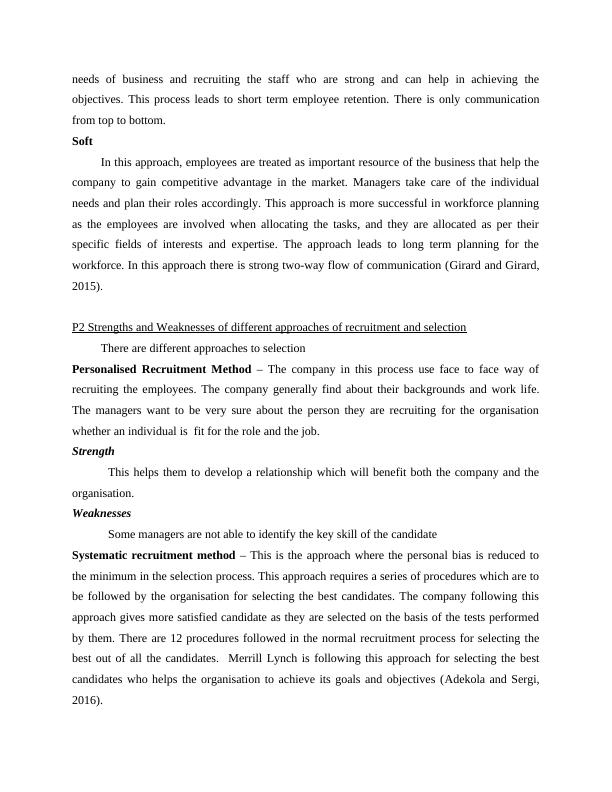
End of preview
Want to access all the pages? Upload your documents or become a member.
Related Documents
Importance of HRM in Workforce Planning and Restructuringlg...
|13
|3782
|74
Benefits of HRM Practices for Employees and Employerslg...
|20
|5223
|89
Human Resource Management - Merrill Lynchlg...
|19
|5838
|126
Functions of HRM for resourcing & workforce planninglg...
|16
|3582
|21
Human Resource Management: Merrill Lynchlg...
|18
|5015
|110
Importance of Employee Relations in HRM Decision Makinglg...
|16
|4051
|21
